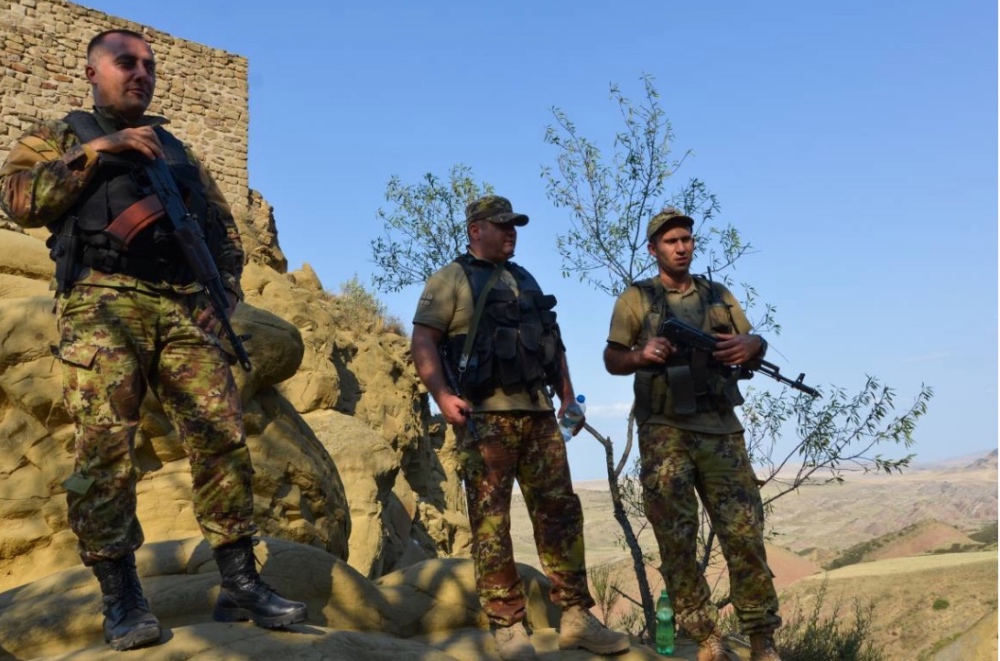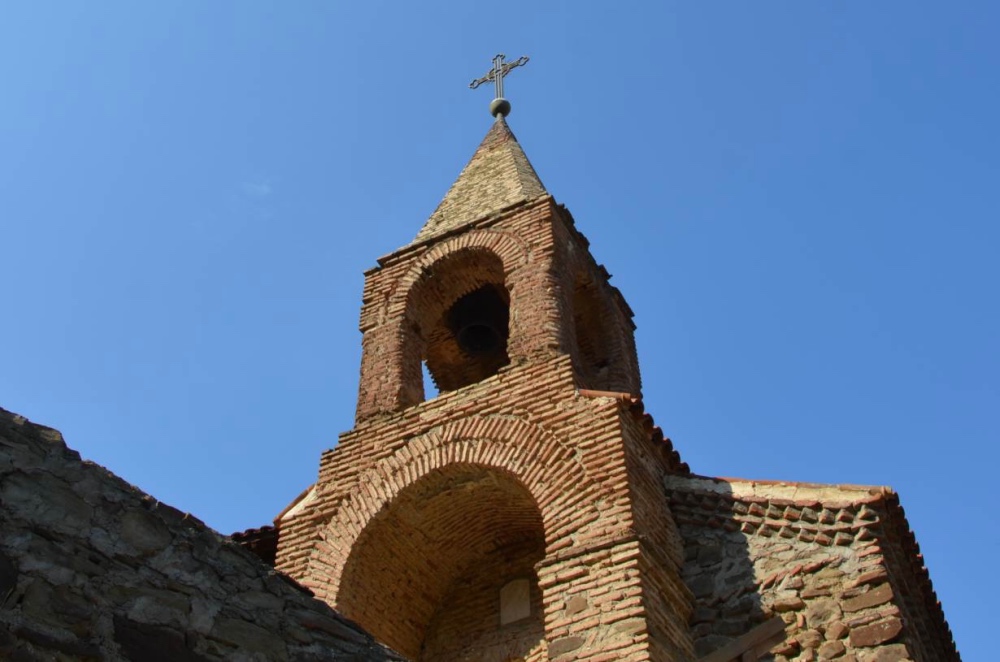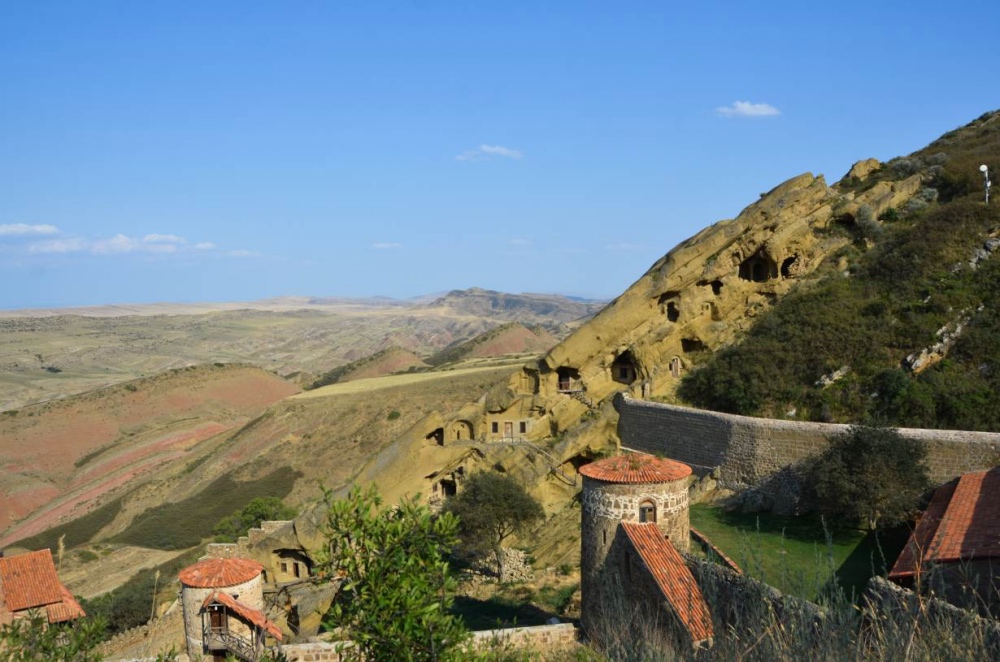
UMBERTO BACCHI, of Thomson Reuters Foundation, reports…
Udabno, Georgia
Thomson Reuters Foundation
Standing near an ancient monastery perched on a rocky ridge in southeast Georgia, armed border guards keep a watchful eye over tourists visiting the site, stopping those who venture too far uphill.
On the ridge’s opposite slope – where the tourists are headed – sit mountain caves with 1,000-year-old religious frescoes etched into their walls, a dozen kilometres from the village of Udabno.
But access has been restricted since late April due to a flare-up in a border dispute between Georgia and Azerbaijan.

Georgian border guards seen on patrol atop the David Gareja monastery in south-eastern Georgia on 1st August. PICTURE: Umberto Bacchi/Thomson Reuters Foundation.
“This is one of the most important religious centres in Georgia,” said Davit Katsarava, a 42-year-old Georgian sportsman and actor protesting the site closure.
“It’s our territory, our history but unfortunately Azerbaijani [people] think otherwise,” he told the Thomson Reuters Foundation during a visit to the monastery.
“This is one of the most important religious centres in Georgia…It’s our territory, our history but unfortunately Azerbaijani [people] think otherwise.”
– Davit Katsarava, a 42-year-old Georgian sportsman and actor.
Almost 30 years after their independence, the two former Soviet republics are yet to agree on exactly where about a third of their shared border runs, and the David Gareja monastery complex is one of the main causes of contention.
From the Baltic region to Central Asia, unresolved border issues are a familiar headache to many post-Soviet countries, often fuelling diplomatic squabbles and conflicts over communities’ access to land and resources.
Demarcation problems came to the fore after the Soviet Union collapsed in 1991 and its fluid internal boundaries became the rigid external frontiers of a host of new nations, leaving many unhappy with the borders they inherited, said experts on the region.
“One kilometre here, one kilometre there wasn’t so important in Soviet days because it was all one country,” said Thomas de Waal, a senior fellow at Carnegie Europe, a Brussels-based think tank.
The Georgian and Azeri foreign ministries did not reply to requests for comment.
Kyrgyzstan, Uzbekistan and Tajikistan have struggled for three decades to agree on their borders in the Ferghana valley, a largely agricultural region that is home to almost a quarter of Central Asia’s population.
Enclaves dotting the region have been the cause of longstanding, sometimes violent quarrels over access to land, infrastructure and water – which is predicted to grow scarcer due to climate change.
At least three people were killed in separate confrontations between Tajik and Kyrgyz villagers earlier this year.

A view of the David Gareja monastery in south-eastern Georgia. Picture taken on 1st August. PICTURE: Thomson Reuters Foundation/Umberto Bacchi
Disputes have also emerged in regions where boundaries are less intricate and sometimes between usually friendly neighbours, said de Waal.
In 2014, Russia and Estonia set out the position of their joint border after more than 20 years of wrangling, but the treaty, which included a small land swap, is yet to be implemented.
Russia has also been disputing ownership of a small border village with Georgia’s breakaway region of Abkhazia, a close ally that heavily relies on financial and political support from Moscow, de Waal added.
Georgia and Azerbaijan set up a joint commission to demarcate the 480 kilometre border between the two countries in 1996, said Kornely Kakachia, head of the Georgian Institute of Politics, a thinktank based in the capital Tbilisi.
But after they agreed on almost 70 per cent of it, progress halted in the mid-2000s, he added.
“At the time, no one cared as nobody cared about churches and monasteries during communism. It was not a problem until Georgia and Azerbaijan became independent.”
– Kornely Kakachia, head of the Georgian Institute of Politics
The David Gareja monastery complex, a sixth-century rock-hewn site sprawling across the barren slopes of a mountain about 60 kilometres south-east of Tbilisi, has represented one of the “major stumbling blocks” to the negotiations, Kakachia noted.
The complex is an important religious landmark for deeply Christian Orthodox Georgia, but the Soviets had allocated a portion of it to Azerbaijan, a mainly Muslim country that also claims historic ties to the site.
“At the time, no one cared as nobody cared about churches and monasteries during communism,” said Kakachia. “It was not a problem until Georgia and Azerbaijan became independent.”
The two countries normally allow visitors to stroll freely around the site but tensions occasionally flare up, prompting closures that anger monks, worshippers and tourists.
The latest crisis erupted in April, when Azerbaijan closed the border in what local media called an apparent retaliation for a visit to the contested site by Georgian President Salome Zurabishvili.
The border has since reopened intermittently.

A view of the David Gareja monastery in south-eastern Georgia. Picture taken 1st August. PICTURE: Thomson Reuters Foundation/Umberto Bacchi
Access restrictions have sparked protests from Georgian clergymen and nationalists, including one in July that led to an altercation between Azeri border guards and protesters.
Tbilisi and Azerbaijan’s Baku, which have friendly relations and strong economic ties, have publicly urged for calm and relaunched delimitation talks.
But there is no easy solution to the border dispute, said Kakachia at the GIP.
A land swap would satisfy Georgians, he said, but Azerbaijan has refused a similar arrangement in the past, citing the military strategic importance of the site, which rests on high ground that dominates the surrounding area.
Baku is also wary that giving up any land could undermine its position in its long-running dispute with neighbouring Armenia over the Nagorno-Karabakh region, Kakachia noted.
Some Azeri historians trace Azerbaijan’s roots back to Caucasian Albanians, who they say established the David Gareja monastery and inhabited Nagorno-Karabakh, an enclave currently controlled by ethnic Armenians inside Azerbaijan, he explained.
“For Baku, any attempts to revise the border are unacceptable. They can provoke a chain reaction,” said Ilgar Velizade, an independent political analyst based in the Azeri capital, in emailed comments.
“For Azerbaijani society…any attempts to change the configuration of borders look like an unfriendly step.”
According to de Waal, relinquishing claims over part of the monastery is also politically hazardous for Tbilisi, as such a move would likely anger nationalists and the powerful Orthodox church.
Foreign control over Georgian land is a particularly sensitive issue in a country where Russian military presence in the two breakaway regions of Abkhazia and South Ossetia is frequently the cause of public anger and turmoil.
“If our government gives up [the monastery]…it will get a revolution,” said Katsarava, the activist.
A possible way out would be to postpone the problem for another 10 or 20 years with an interim sharing agreement, said Kakachia of the GIP.
But that is unlikely to be reached until emotions calm down, he added.
Meanwhile, Irakli Shengelia, founder of Kartveli Tours, a travel agency, said the company had largely stopped promoting visits to the site, expecting tourists to cancel their plans upon learning part of the monastery was closed.
“It’s frustrating,” said Shengelia. “It’s a very unique place like no other in Georgia and possibly the world and it’s basically being wasted right now…we really hope that this issue gets resolved soon”.





